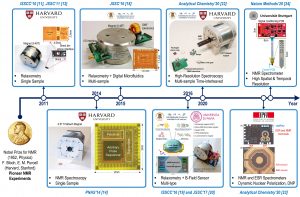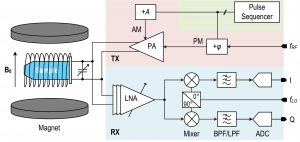A research team led by Lei Ka Meng, assistant professor in the University of Macau (UM) Institute of Microelectronics, and his PhD student Fan Shuhao have published an article titled ‘Miniaturization of a Nuclear Magnetic Resonance System: Architecture and Design Considerations of Transceiver Integrated Circuits’ to provide a practical guide for implementing customised and miniaturised NMR-on-a-chip platforms for on-site and real-time analyses outside the laboratory. The paper has been published by the renowned international journal IEEE Transactions on Circuits and Systems–I: Regular Papers (IEEE TCAS-I) and selected as a highlight paper of the journal in August 2022.
The nuclear magnetic resonance (NMR) system is one of the most important analytical tools available in chemistry and biology, with the ability to elucidate the structure and function of molecules at atomic resolution. Compared to microscopes and X-ray diffractometers, an NMR system is simple to operate and radiation-free and thus has been widely used in many areas, such as organic chemistry, medicinal chemistry, structural biology, medical imaging, and geological survey. Related developments and applications of the technology has garnered five Nobel Prizes, in 1944, 1952, 1991, 2002, and 2003, respectively. Despite this profound impact, NMR suffers a critical drawback: it is too large. Its heavy and also costly instrumentation, including a bulky superconducting magnet and discrete electronics, prevents it from being used for fast testing and in an outdoor environment. Therefore, by integrating the electronic components of the NMR system onto a chip, such as a transceiver, it is possible to create a truly portable NMR system with a smaller footprint and higher testing efficiency that can make on-site, on-demand and real-time analyses available.
Since 2011, at least 30 papers, including 11 papers by the UM team, on topics related to implementing NMR electronics on a customised integrated circuit have been published in journals such as Nature Methods, Analytical Chemistry, IEEE TCAS-I, and IEEE Journal of Solid-State Circuits and conferences such as IEEE International Solid-State Circuit Conference and IEEE Symposium on VLSI Circuits. Most of the papers only briefly discuss the general architecture of the transceiver for the NMR system without covering its design considerations. With this in mind, the UM team aimed to create a design-orientated tutorial to cover the design considerations of customised transceivers for NMR systems in detail.
This paper describes the design considerations of transmitters and receivers that are the cornerstones of micro-NMR systems, such as receiver linearity, phase noise, and power amplifier output power, with the aim of providing a practical guide for implementing customised and miniaturised NMR-on-a-chip platforms for on-site and real-time analyses outside the laboratory. Prof Lei is the paper’s corresponding author and Fan is the first author. PhD student Zhou Qi, Prof Mak Pui In, and Prof Rui Martins also made important contributions to the paper.
To view the full version of the paper, please visit: https://ieeexplore.ieee.org/document/9816120/
| Source: Institute of Microelectronics | |
| Media Contact Information: | |
| Communications Office, University of Macau | |
| Albee Lei | Tel: (853) 8822 8004 |
| Cathy Cheang | Tel: (853) 8822 8009 |
| Email: | prs.media@um.edu.mo |


